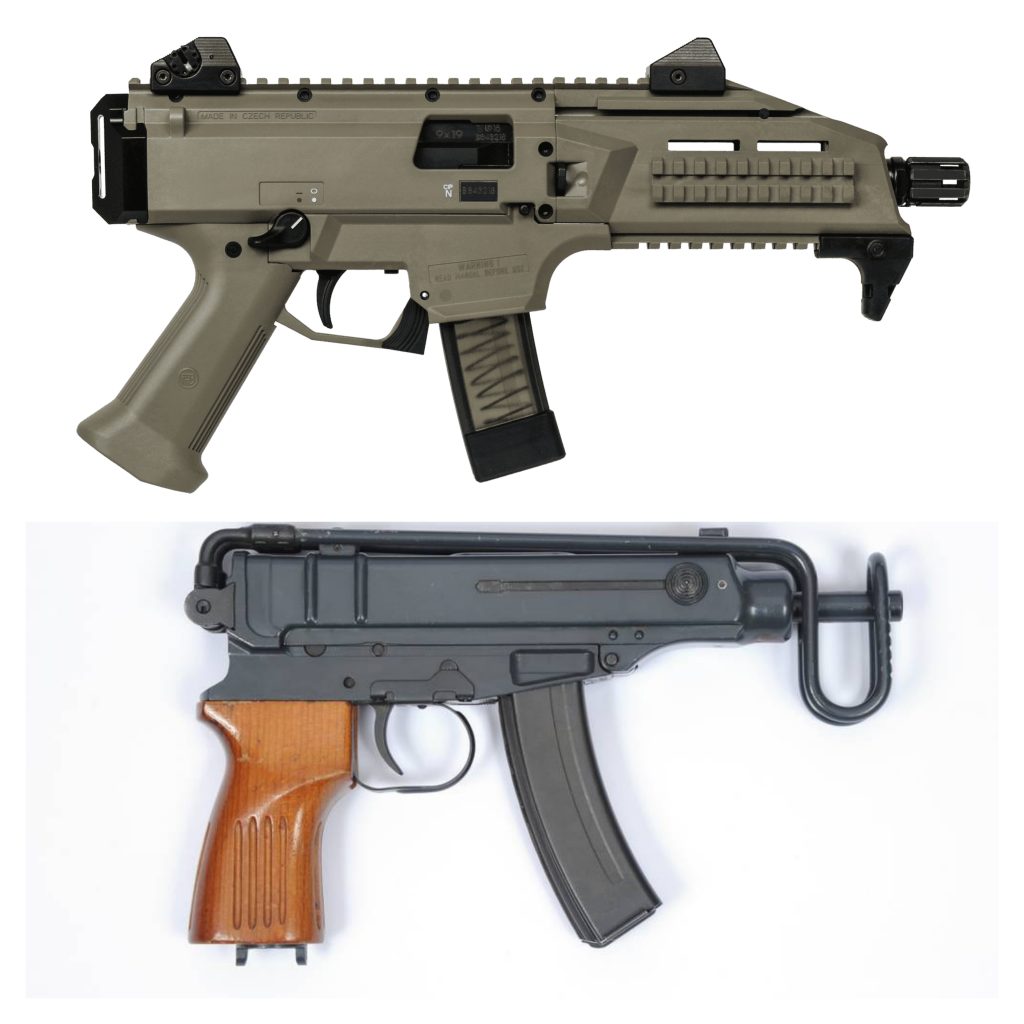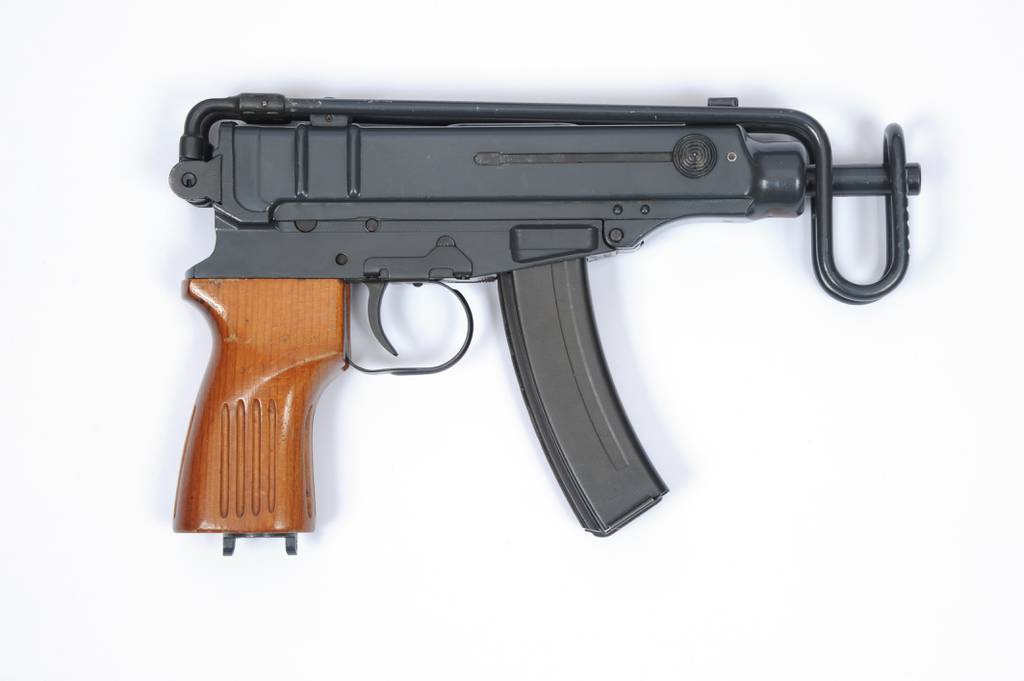The Czech may have been locked behind the Iron Wall of the Soviet Union, but they were never one to fall in line with Soviet doctrine. We see this with the CZ 75 and the vz. 58, and the subject of today’s article—the vz. 61 Skorpion. The fascinating vz. 61 Skorpion was superbly successful for its design. Over time the platform evolved, and eventually, the CZ Scorpion Evo series became its successor. Today we’ll examine the evolution of the Skorpion and how it became the Scorpion Evo series.

The First Skorpion
As the name implies, the Skorpion came to be in 1961 and was produced originally for security forces, but it eventually found its way into the hands of Czech military forces. Categorizing this firearm can be tough. It’s easy to argue that it’s a submachine gun, but it’s also easy to see the argument of those who claim it’s a machine pistol.
If it’s a machine pistol, it’s likely the most successful and easy-handling machine pistol ever made. If it’s a submachine gun, it’s a subcompact variant that’s as small as an SMG gets.
The argument that it’s a machine pistol is that it easily fired in semi-auto as a standard handgun. You don’t need to employ the stock to land effective hits. It’s also easily carried in a holster on the belt, and that’s how the Czech forces carried it. Using the .32 ACP round is also an interesting choice and points it more in the pistol direction.

The argument that it’s an SMG focuses on the addition of a folding stock as well as its placement of the magazine forward of the pistol grip. It’s easy to categorize it as some odd in-between of an SMG or machine pistol.
The use of .32 ACP made this ultra-small gun quite easy to control in full auto fire. The steel over-folding stock is as minimalist as it gets and wouldn’t support much more than a light caliber.
Inside the Skorpion
The original Skorpion was a direct blowback firearm that fired from a closed bolt. This is common now, but in 1961 closed-bolt SMGs weren’t common. It was quite the advancement. The light shooting .32 ACP made the weapon controllable and helped with the recoil associated with direct blowback weapons.
The weapon also has a rate reducer which took the rate of fire from 1,000 rounds per minute to a more controllable 850 RPM. The rate reducer was housed in the pistol grip and was simple but effective. To keep the gun small the Czech engineers used a telescopic bolt that encases a good bit of the barrel.
Size-wise, the gun was just over 10 inches with the stock folded, and it weighed a mere 2.87 pounds. That’s ultra-small and lightweight for a submachine gun. Part of the design was aimed at certain special operations forces.
This includes the compact nubs, which allowed for concealed shooting through luggage, clothing, etc, without a charging handle getting caught up. The weapon was made to be easy to suppress and easy to control. The use of .32 ACP was on purpose and because of its commonality.
CZ was already making quite a few .32 ACP pistols like the .vz 50. Also, .32 ACP was incredibly common around the world in this era, so if your black ops team was shopping at Bass Pro during the Cold War, they could find ammunition.
Modern Demands and Modern Guns
The Skorpion was a successful firearm. It was exported widely and fell into the hands of security forces, military members, paratroopers, and even unsavory groups like the IRA and the Red Brigades. However, it quickly found itself being outperformed due to its caliber.
In a pocket pistol, .32 ACP is pretty good, but in an SMG, it leaves something to be desired. It lacked substantial penetration, sucked against any kind of barrier, and did diddly even against the rather weak body armors of the time.

This forced the Czech to begin adapting the gun to various calibers, including 9mm Makarov, which would open it up to more exports and help standardize with other Soviet forces. Eventually, they produced a .380 ACP variant as well. The .vz 68 was a 9mm parabellum variant built for export.
Still, guns like the MP5 were proving to be the champion of SMGs. CZ backed off the Skorpion and worked on other designs. In the late 1980s, they tried again with the .vz 82 and 83, but it fizzled once more.
The Second Generation of Skorpion
In the early 2000s, CZ began building the second generation of Skorpions. They ditched the more anemic calibers and embraced 9mm Parabellum. They added a rail underneath the barrel and beefed the gun up.

In 2005 they produced the XCZ 868. It seems they wanted to attract military contracts with the promise of a modern 9mm SMG. The XCZ 868 was a 9mm Skoprion with a rail underneath the barrel. Prototypes featured a more modern stock, as well as a short rail ready for an optic and a suppressor. The charging handle became non-reciprocating, and you could mount a light if desired. This was the last gasp of a dying platform.
While it featured all the fancy features of a modern Skorpion, these accessories were more or less just tacked on to a design from 1961. When this design failed to succeed, CZ began looking elsewhere.
Enter the Evo 3
The Skorpion became the Scorpion Evo 3 after a Czech company called Laugo developed a more modern 9mm SMG for the military and police market. CZ purchased the design and set about making it more modern, more ergonomic, and tweaking this and that until the Evo 3 was produced.

While it shared a direct blowback operating system with the Skorpion, it doesn’t share much else. It’s a more modern SMG that mixed a heavy dose of polymer into the gun’s construction. The Scorpion was never built to be a subcompact SMG or machine pistol but a full-sized SMG on par with guns like the MP5.
The EVO 3 saw quick acceptance by the military and police community. The Czech military purchased the gun, as did numerous other military forces around the world. This uber-modern SMG packed modularity, great ergonomics, and a modern design open to all manner of optics, lights, lasers, and cup holders.

In the civilian world, the Evo 3 S1 became an instant hit and is sold as a pistol, rifle, and even a bullpup gun. The Evo 3 has evolved into the Evo 3+, which changed some of the ergonomics and enhanced the design overall. Both have been successful and have taken the small SMG crown from its forefather, the Skorpion.

